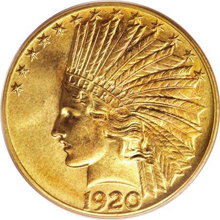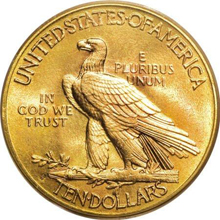 1920-S $10 MS67 PCGS. This is an astonishingly beautiful and Superb example of this famous 20th century rarity. It is the highest graded specimen by both PCGS and NGC, and the only 1920-S graded MS67. "Finest Known" is a term that is perhaps used too often by enthusiastic catalogers when describing a particularly notable example of a rare issue, but that accolade can be applied without hesitation or dispute to the 1920-S eagle offered here.
1920-S $10 MS67 PCGS. This is an astonishingly beautiful and Superb example of this famous 20th century rarity. It is the highest graded specimen by both PCGS and NGC, and the only 1920-S graded MS67. "Finest Known" is a term that is perhaps used too often by enthusiastic catalogers when describing a particularly notable example of a rare issue, but that accolade can be applied without hesitation or dispute to the 1920-S eagle offered here.
The coin is boldly struck on the obverse with LIBERTY sharp and full, including the last three letters RTY, which are often weak or even missing on many examples of this issue. The hair curls around the face are also complete and sharply defined, something rarely, if ever, encountered on a 1920-S eagle. The numerals 19 in the date are slightly weak, as usual. The reverse is also generally well struck except on the eagle's trailing leg feathers, talons, and the arrows below. Weakness in this area is characteristic of every example of this issue that we have seen, but even here the strike is well above average. Overall, this coin is quite different in appearance from virtually every other known 1920-S eagle since it has an almost medallic look with sharp, squared edges and broad, flat inner borders. In addition to its unusually sharp striking qualities, the things that are most impressive about this particular coin are its originality, color, luster, and overall eye appeal. The color is a rich, deep orange-gold and the nearly flawless, mark-free frosty surfaces have a radiant luster that sets this coin above and apart from virtually any other known Indian Head eagle, regardless of date. In our opinion, this is the most important and desirable Saint-Gaudens eagle in existence. The interest and subsequent bidding on this lot will almost certainly justify that claim with a new record price for the issue as well as the series. However, remember that when Dr. Steven Duckor purchased this coin for $85,000 at auction in 1979 he also paid a record price, an amount that was widely considered to be excessive for the time. But that is what it almost always takes to buy a coin like this, and yet no matter what the winning bid is today, it will ultimately prove to be a bargain since, once this coin is sold, the same amount of money (or possibly much more) could not buy its equal.
 Since at least the 1930s, the 1920-S eagle has been known and appreciated as rare and, by the time of the publication of the first edition of the Red Book in 1947, the 1920-S was already considered tied with the 1930-S for the position of third rarest issue of the series after the 1907 Rolled Rim and 1933. (It is intriguing to note that after 60 years, the top four population rarities of the series have remained constant, although the 1920-S is now recognized to be clearly rarer than the 1930-S in all grades.) The mintage of 126,500 pieces, although relatively low, barely places the 1920-S in the top 10 lowest mintage regular issues of the series, but its survival rate obviously has been extremely low. At the present time, fewer than 100 pieces of this issue have been certified in all grades by PCGS and NGC combined, split almost evenly between circulated examples and Mint State ones. Most circulated examples are at the high end of the scale, AU55 to 58, while most of the Uncirculated ones are at the low end of the Mint State scale, MS60 to 63. Allowing for an unknown but presumably small number of examples that exist but have not been certified, as well as duplication among those that have already been graded, a reasonable estimate of the total number of examples of this issue in existence would be in the range of 125-150 pieces at most, and that estimate actually may be high. In terms of overall population rarity, this estimate places the 1920-S third behind the 1933 and 1907 Rolled Rim, of which fewer than 50 examples of each issue are known. However, in addition to its significant rarity in terms of the total number of examples known (the "population rarity") the 1920-S is also the quintessential example of what is commonly called a "condition rarity." In fact, it is the premier condition rarity in the entire Indian Head eagle series, with fewer examples known and graded MS63 and higher and MS64 and higher than any other issue in the series. A review of the most recent population data from PCGS and NGC shows that in grades of MS63 and higher, the condition rarity ranking of the top five issues in the series is as follows: 1. 1920-S; 2. 1933; 3. 1913-S; 4. 1911-D; and 5. 1907 Rolled Rim. In this ranking, the 1920-S is approximately 50% rarer than the next rarest issue, the 1933. When considering the condition rarity ranking in grades of MS64 and higher, the order looks like this: 1. 1920-S; 2. 1911-D; 3. 1933; 4. 1913-S; and 5. 1907 Rolled Rim. In this ranking, the 1920-S is roughly two and a half times rarer than the next three, which are virtually equal, and more than five times rarer than the 1907 Rolled Rim. This analysis clearly shows why the appearance at auction of a high grade 1920-S ten always generates excitement among prospective bidders.
Since at least the 1930s, the 1920-S eagle has been known and appreciated as rare and, by the time of the publication of the first edition of the Red Book in 1947, the 1920-S was already considered tied with the 1930-S for the position of third rarest issue of the series after the 1907 Rolled Rim and 1933. (It is intriguing to note that after 60 years, the top four population rarities of the series have remained constant, although the 1920-S is now recognized to be clearly rarer than the 1930-S in all grades.) The mintage of 126,500 pieces, although relatively low, barely places the 1920-S in the top 10 lowest mintage regular issues of the series, but its survival rate obviously has been extremely low. At the present time, fewer than 100 pieces of this issue have been certified in all grades by PCGS and NGC combined, split almost evenly between circulated examples and Mint State ones. Most circulated examples are at the high end of the scale, AU55 to 58, while most of the Uncirculated ones are at the low end of the Mint State scale, MS60 to 63. Allowing for an unknown but presumably small number of examples that exist but have not been certified, as well as duplication among those that have already been graded, a reasonable estimate of the total number of examples of this issue in existence would be in the range of 125-150 pieces at most, and that estimate actually may be high. In terms of overall population rarity, this estimate places the 1920-S third behind the 1933 and 1907 Rolled Rim, of which fewer than 50 examples of each issue are known. However, in addition to its significant rarity in terms of the total number of examples known (the "population rarity") the 1920-S is also the quintessential example of what is commonly called a "condition rarity." In fact, it is the premier condition rarity in the entire Indian Head eagle series, with fewer examples known and graded MS63 and higher and MS64 and higher than any other issue in the series. A review of the most recent population data from PCGS and NGC shows that in grades of MS63 and higher, the condition rarity ranking of the top five issues in the series is as follows: 1. 1920-S; 2. 1933; 3. 1913-S; 4. 1911-D; and 5. 1907 Rolled Rim. In this ranking, the 1920-S is approximately 50% rarer than the next rarest issue, the 1933. When considering the condition rarity ranking in grades of MS64 and higher, the order looks like this: 1. 1920-S; 2. 1911-D; 3. 1933; 4. 1913-S; and 5. 1907 Rolled Rim. In this ranking, the 1920-S is roughly two and a half times rarer than the next three, which are virtually equal, and more than five times rarer than the 1907 Rolled Rim. This analysis clearly shows why the appearance at auction of a high grade 1920-S ten always generates excitement among prospective bidders.